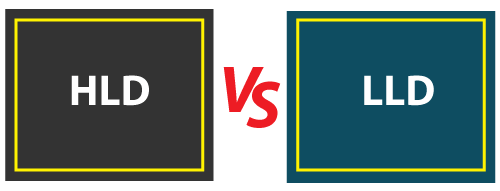In this section, we are going to discuss the difference between HLD and LLD; and see the brief introduction between them.
What is HLD?
The HLD stands for High-Level Design, where the designer will only focus on the various models, like:
- Decision Tables
- Decision Trees
- Flow Diagrams
- Flow Charts
- Data Dictionary
The solution architect develops the High-level design, which is used to specifies the complete description or architecture of the application.
The HLD involves system architecture, database design, a brief description of systems, services, platforms, and relationships among modules.
The HLD is also known as macro-level or system design. It changes the business or client requirement into a High-Level Solution.
The High-level design is created before the Low-Level Design.
What is LLD?
The LLD stands for Low-Level Design, in which the designer will focus on the components like a User interface (UI).
The Low-level design is created by the developer manager and designers.
It is also known as micro-level or detailed design. The LLD can change the High-Level Solution into a detailed solution.
The Low-level design specifics the detailed description of all modules, which implies that the LLD involves all the system component's actual logic. It goes deep into each module's specification.
The Low-level design is created after the High-Level Design.
HLD vs LLD
In the below table, we have discussed some significant comparisons between high-level design and low-level design.

|
S.NO. |
Comparison Basis |
HLD |
LLD |
|
1. |
Stands
for |
It stands for
High-Level Design. |
It stands for
Low-Level Design. |
|
2. |
Definition |
It is the general
system design, which means it signifies the overall system design. |
It is like
describing high-level design, which means it signifies the procedure of the
component-level design. |
|
3. |
Purpose |
The HLD states the
concise functionality of each component. |
LLD states the
particular efficient logic of the component. |
|
4. |
Also,
known as |
HLD is also called a
System or macro-level design. |
LLD is also called
details or micro-level design. |
|
5. |
Developed
by |
Solution Architect
prepares the High-Level Design. |
Designer and
developer prepare the Low-Level Design. |
|
6. |
Sequential
order in the design phase |
It is developed
first in sequential order, which implies that the HLD is created before the
LLD. |
It is developed
after High-level design. |
|
7. |
Target
Audience |
It is used by
management, program, and solution teams. |
It is used by
designers, operation teams, and implementers. |
|
8. |
Conversion |
The HLD changes the
client or business requirement into a high-level solution. |
The LLD changes the
high-level solution to a comprehensive solution. |
|
9. |
Probable
output |
The high-level
design is necessary to understand the flow across several system objects. |
A low-level design
is required for creating the configurations and troubleshooting inputs. |
|
10. |
Input
Criteria |
The input measure in
high-level design is SRS (Software Requirement Specification). |
The input measure in
low-level design is the reviewed HLD (High- Level Design). |
|
11. |
Output
Criteria |
The output measures
in the HLD are functional design, database design, and review record. |
The output bases in
the low-level design are the unit test plan and program specification. |
Conclusion
In this section, we have understood the major difference
between high-level and low-level designs.
And we can conclude that the high-level design specifies
the complete report and planning of the particular software product or
application. On the other hand, the low-level design specifies
the in-detail report of all the modules.
In Software
Development Life Cycle's design phase, the members of
design team, client team, and review teams are included in high-level
designing. On the other hand, the design team and operation teams will prepare
the low-level Design.
Finally, we can say that both HLD and LLD are
essential part of design phase in the SDLC process for any software product.



0 Comments